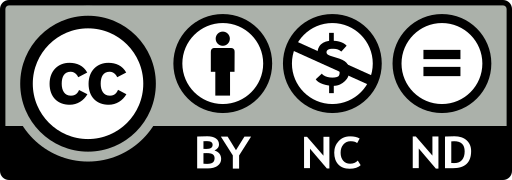Voice Therapy Intervention on artists
Intervención fonoaudiológica en artistas towards a complete look at vocal intervention
This work is licensed under a Creative Commons Attribution-NonCommercial-NoDerivatives 4.0 International (CC BY-NC-ND 4.0).
Show authors biography
Nowadays the knowledge is advancing by leaps and bounds. The number of Speech Pathologists in different areas of the profession has increased. The artistic area calls the attention of many, because it is a hardly explored and wide area. This article aims to reflect on vocal intervention on artists (singers, actors and others). Its implementation should include a thorough overview of the person: voice, physiology, physiopathology, emotions, role, medical and pharmacological aspects and individual characteristics. This promotes the adhesion of a voice professional to their area of its own knowledge, thus allowing a space for healing, exploration and artistic freedom in current terms, even in the midst of a pandemic.
Article visits 2073 | PDF visits 1402
- Petty BE. Diagnosis and treatment for the professional singer. ASLHA. 2013 Mar;23(1):15-21. DOI: https://doi.org/10.1044/vvd23.1.15
- Kitch J, Oates J. The perceptual features of vocal fatigue as self-reported by a group of actors and singers. J Voice. 1994 Sep;8(3):207-214. DOI: https://doi.org/10.1016/S0892-1997(05)80291-7
- Risser R. Balancing the art and science of the singing voice. ASLHA. 2015 Nov;25(3):110-115. DOI: https://doi.org/10.1044/vvd25.3.110
- Adessa M, Stadelman-Cohen T, Zipse L, Guarino AJ, Heaton JT. Factors affecting voice therapy completion in singers. J Voice. 2018 Sep;32(5):564-571. DOI: https://doi.org/10.1016/j.jvoice.2017.06.021
- American Speech-Language-Hearing Association [Internet]. [lugar desconocido]: ASHA ad hoc joint committee with the national association of teachers of singing and the voice and speech trainers association; c1997-2020. The role of the speech-language pathologist, the teacher of singing, and the speaking voice trainer in voice habilitation [Technical Report]; 2005 [consultado el 3 de agosto de 2020]. Disponible en: https://www.asha.org/policy/TR2005-00147.htm
- Muckala J. Voice rehabilitation and resilience work with the commercial singer: a concept piece. ASLHA. 2020 Feb;5(1):102-112. DOI: https://doi.org/10.1044/2019_PERSP-19-00074
- Goulart BNG, Rocha JG, Chiari BM. Intervenção fonoaudiológica em grupo a cantores populares: estudo prospectivo controlado. J Soc Bras Fonoaudiol. 2012;24(1):7-18. DOI: https://doi.org/10.1590/S2179-64912012000100004
- Amin E. Terapia vocal de cantantes: una reflexión sobre la práctica. Areté. 2018 Jul-Dic;20(2S):37S-44S. DOI: https://doi.org/10.33881/1657-2513.art.182S05
- Montilla K. El twang: en el estill voice y en la técnica vocal completa. Areté. 2018;20:63S-67S. DOI: https://doi.org/10.33881/1657-2513.art.182S08
- Bourne T, Kenny D. Vocal qualities in music theater voice: perceptions of expert pedagogues. J Voice. 2016;30(1):128.e1-128.e12. DOI: http://dx.doi.org/10.1016/j.jvoice.2015.03.008
- Maxfield L, Manternach B. Perceptual differences between novice and professional music theater singers. J Voice. 2017;32(5):572-577. DOI: https://doi.org/10.1016/j.jvoice.2017.08.007
- López García J. Protocolo de entrenamiento vocal fonoaudiológico para cantantes. Areté. 2019;19(2):61-74. DOI: https://doi.org/10.33881/1657-2513.art.19207
- Bustos Sánchez, I. Abordaje holístico y potenciación del filtro vocal en alteraciones de la voz. Areté. 2018;18(2):55-64. DOI: https://doi.org/10.33881/1657-2513.art.18205
- Azocar Fuentes MJ. Atención fonoaudiológica vocal a actores: la opción (o necesidad) de aportar en la promoción de su bienestar vocal-emocional. Areté 2018;20(2S):31S-36S. DOI:https://doi.org/10.33881/1657-2513.art.182S04
- Sataloff R. Arts medicine: an overview for choir conductors. Choral Journal. 2008 Nov;49(5):24-33. Disponible en: https://www.jstor.org/stable/i23556962
- Chen D, Singer RN. Self-regulation and cognitive strategies in sport participation. Int J Sport Psychol. 1992;23:277–300.
- Sielska-Badurek E, Osuch-Wójcikiewicz E, Sobol M, Kazanecka E, Niemczyk K. Singers’ vocal function knowledge levels, sensorimotor self-awareness of vocal tract, and impact of functional voice rehabilitation on the vocal function knowledge and self-awareness of vocal tract. J Voice. 2017 Ene;31(1):122.e17-122.e24. DOI: http://dx.doi.org/10.1016/j.jvoice.2016.01.011
- Saldías M, Guzman M, Sandoval G, Vergara C, Lizana J, Quezada C. Water resistance therapy as vocal warm-up method in contemporary commercial music singers. Folia Phoniatrica et Logopaedica. 2020 Mar;72(1):1-12. doi: https://doi.org/10.1159/000494722
- Guzman M, Angulo M, Muñoz D, Mayerhoff R. Effect on long-term average spectrum of pop singers’ vocal warm-up with vocal function exercises. International Journal of Speech-Language Pathology, 2013;15(2):127–135. DOI: https://doi.org/10.3109/17549507.2012.702283
- Saldías M, Guzman M, Miranda G, Laukkanen A. A computerized tomography study of vocal tract setting in hyperfunctional dysphonia and in belting. J Voice. 2019;33(4):412-419. DOI: https://doi.org/10.1016/j.jvoice.2018.02.001
- Gopikishore P, Pushpavathi M. Outcomes of eclectic voice therapy program in the treatment of hyperfunctional voice disorders: a preliminary study. Glob J Oto 2017;8(2):555732. DOI: https://doi.org/10.19080/GJO.2017.08.555732
- Thomas LB, Stemple JC. Voice therapy: does science support art? Communicative Disorders Review. 2007;1(1):49-77. Disponible en: https://www.researchgate.net/publication/284677065_voice_therapy_does_science_support_the_art
- Thalen M, Sundberg J. Describing different styles of singing. a comparison of a female singer’s voice source in ‘‘classical’’, ‘‘pop’’, ‘‘jazz’’ and ‘‘blues’’. Log Phon Vocol. 2001;26(2):82-93. DOI: https://doi.org/10.1080/140154301753207458
- Cantarella G, Barillari M, Lechien J, Pignataro L. The challenge of virtual voice therapy during the COVID-19 pandemic. J Voice. 2020 Jun. “en prensa”. DOI: https://doi.org/10.1016/j.jvoice.2020.06.015
- Ohlstein JF, Garner J, Takashima M. Telemedicine in Otolaryngology in the COVID-19 Era: Initial Lessons Learned. The Laryngoscope. 2020 “en prensa” DOI: https://doi.org/10.1002/lary.29030
- Lavinsky J, Kosugi EM, Baptistella E, Roithmann R, Dolci E, Ribeiro TK, et al. An update on COVID-19 for the otorhinolaryngologist - a Brazilian Association of Otolaryngology and Cervicofacial Surgery (ABORL-CCF) Position Statement. Braz J Otorhinolaryngol. 2020;86(3):273-280. DOI: https://doi.org/10.1016/j.bjorl.2020.04.002
- Castillo-Allendes A, Contreras-Ruston F, Cantor L, Codino J, Guzman M, Malebran C, et al. Voice therapy in the context of the covid-19 pandemic; guidelines for clinical practice. J Voice. 2020 “en prensa” doi: https://doi.org/10.1016/j.jvoice.2020.08.001




